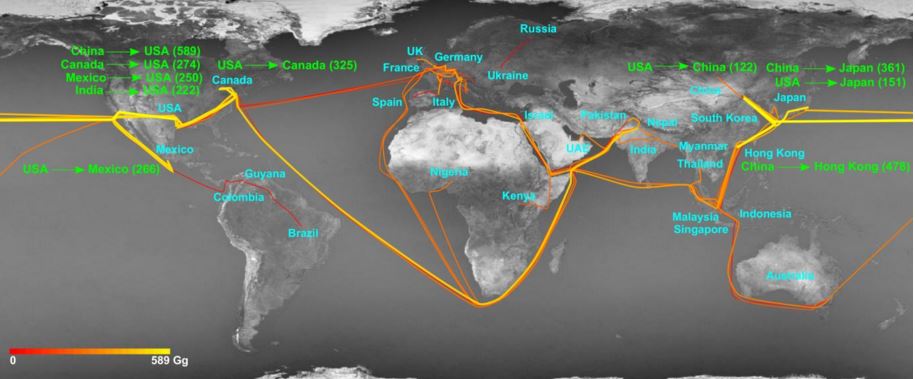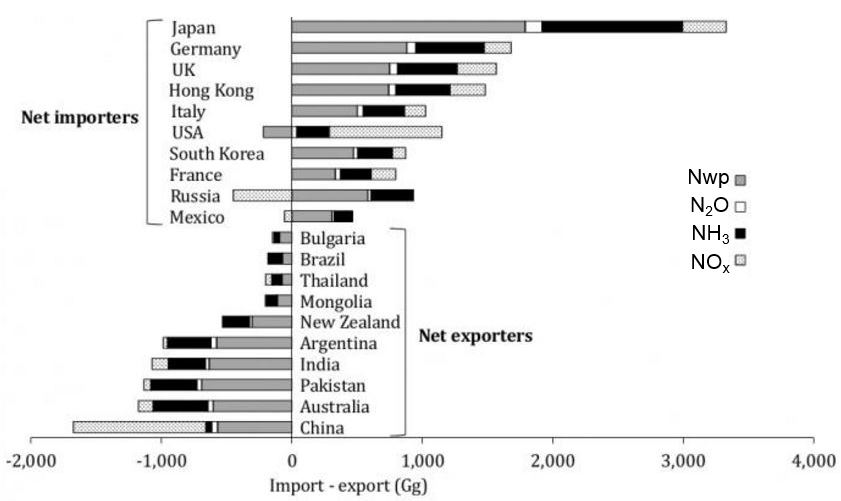Nearly half of all nitrogen emissions (46%) come from just four countries – Brazil, India, China and the United States – according to a new study by Australian and Japanese scientists. Developing nations tend to embody large quantities of nitrogen emissions from their exports of clothing, food and textiles, the researchers found.
The study, led by by the University of Sydney’s Integrated Sustainability Analysis team in the Faculty of Science, reported in the academic journal Nature Geoscience that Australia is one of the few advanced economies that is a net nitrogen exporter, because of its substantial agriculture industry.
The economic modelling used by the international team of scientists, which grouped the nitrogen footprint into top-ranking bilateral trade arrangements, noted a trend for ever-increasing nitrogen production, and found that the rich countries are largely responsible for emissions abroad for their own consumption.
 Nitrogen international trade routes and intensity. (Image: Nature. Credit: University of Sydney)
Nitrogen international trade routes and intensity. (Image: Nature. Credit: University of Sydney)
Put simply, demand at home in the rich countries makes the developing nations increase their nitrogen emissions, because that is where the products are coming from.
Co-author Ms. Arunima Malik, a PhD candidate, along with colleagues from the University of Sydney, Dr. Arne Geschke and Professor Manfred Lenzen, as well as one scientist from Kyushu University and two researchers from Yokohama National University, both in Japan, said major nitrogen net importers were nearly exclusively developed countries.
Regarding nitrogen emissions and rich countries, Ms. Malik said:
“High-income nations are responsible for more than 10 times the emissions of the poorest nations. This reflects greater consumption of animal products, highly processed foods and energy-intensive goods and services.”
By far, most of the emissions came from industries such as energy generation, transport and agriculture. Sewage made up the bulk of emissions from consumers-end use.
 Net importers and net exporters of nitrogen emissions. (Image: nature.com)
Net importers and net exporters of nitrogen emissions. (Image: nature.com)
Nitrogen emissions often refers to nitrous oxide
According to the United States Environmental Protection Agency (EPA), nitrous oxide (N2O) is naturally present in the Earth’s atmosphere as part of its nitrogen cycle, and has several different sources.
Human activities, such as fossil fuel combustion, agriculture, wastewater management, and industrial processes are increasing the amount of N2O in the atmosphere.
N2O molecules remain in the atmosphere for about 114 years (average) before being removed by a sink or destroyed through chemical reactions. One pound of N2O on warming our atmosphere is nearly 300 times that of one pound of carbon dioxide (CO2).
The EPA estimates that about 40% of all N2O emissions come from human activity.
Nitrogen pollution was becoming a rapidly-growing problem, as countries not only consumed nitrogen, but were also producing greater amounts of synthetic nitrogen, Prof. Lenzen explained. New work by scientists at the University of Sydney looking at trends should be completed soon.
 Nitrogen footprints per capita. Net importers are causing emissions more abroad in order to satisfy their consumption than they generate emissions because of their exports, and vice versa for net exporters. (Image: nature.com)
Nitrogen footprints per capita. Net importers are causing emissions more abroad in order to satisfy their consumption than they generate emissions because of their exports, and vice versa for net exporters. (Image: nature.com)
Prof. Lenzen said:
“Polices are needed to integrate nitrogen supply-chains globally in order to reduce pollution. We know nitrogen emissions are increasing – just as carbon emissions are increasing as populations expand.”
“We are now analysing the trends, such as increased affluence and consumption, and looking at the various industries responsible for nitrogen pollution.”
Highlights of the research of 2010 data:
– Consumption in Brazil, India, China and the US is responsible for 46% of global nitrogen emissions globally.
– Japan and other rich countries import reactive nitrogen embodied in Chinese-made clothing as well as Australian and American meat.
– France, Italy, Germany and the United Kingdom exchange considerable amounts of nitrogen emissions embodied in food products.
– Hong Kong’s nitrogen imports are mainly raw food and agricultural products, because it does not have enough land to produce its own crops and livestock.
– Thailand, Pakistan, India, China and other developing nations embody large amounts of nitrogen emissions into the exports of clothing and textiles.
– Rich nation exceptions are New Zealand, Australia and Argentina, which export significant nitrogen embodied in livestock products.
– Emissions per capita (per person) ranged from over 100 kg per year for rich nations such as Luxembourg and Hong Kong, to less than 7 kg for Papua New Guinea, Liberia and Côte d’Ivoire (Ivory Coast).
– Of the 189 teragrams (Tg) of nitrogen emitted globally in 2010, 161 Tg was emitted from agriculture and industries, and just 28 Tg was emitted by consumers. A teragram is unit of mass equal to 1012 (one trillion) grams.
Reducing you nitrogen footprint
According to Alley Leach, a PhD student in the NRESS (Natural Resources and Earth Systems Science) Program at the University of New Hampshire, anything you do that reduces your carbon footprint will also reduce that of nitrogen.
For example, if your energy consumption goes down, whether by switching off the lights when you exit a room, use public transport, walk, or travel by bicycle – instead of driving a car – you reduce both footprints.
 If we all focussed on our nitrogen footprint a little bit more, we would be much more effective in helping combat climate change. (Image: n-print.org)
If we all focussed on our nitrogen footprint a little bit more, we would be much more effective in helping combat climate change. (Image: n-print.org)
However, the largest nitrogen contributor is waste and food production, which combined make up more than 75% of the average human’s nitrogen footprint.
The average US citizen contributes 27 kg of nitrogen pollution each year, and that is just from food production and consumption.
So, how could you practice sustainable eating habits? Consume your recommended amount of daily protein – 46 grams per day for adult women and 56 grams per day for adult men – with less animal protein nitrogen-intensive meat, get your food from sustainable farms, and cut down on your food waste.
If each person consumed the recommended amount of nitrogen (3 kg N/capita/year), instead of the current consumption amount (5.3 kg N/capital/year), their nitrogen footprint from food consumption and production would be reduced by nearly 50%.
Two citations:
1. “Substantial nitrogen pollution embedded in international trade,” Azusa Oita, Arunima Malik, Keiichiro Kanemoto, Arne Geschke, Shota Nishijima & Manfred Lenzen. Nature Geoscience. 25 January 2016. DOI: doi:10.1038/ngeo2635.
2. “Sustainability: Your feet’s too big,” James N. Galloway & Allison M. Leach. Nature Geoscience. 25 January 2016. DOI: 10.1038/ngeo2647.

